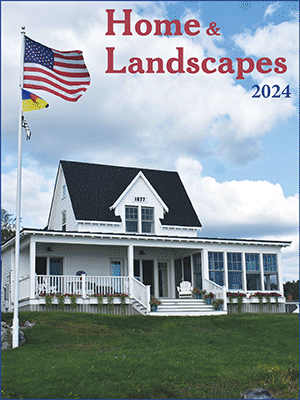Kinglets in a Cold Place
 The presence of golden-crowned kinglets is more often revealed through its rapid, high-pitched calls, but in seeing one up close, their beauty is spectacular. Photo by Rhododendrites, courtesy of Wikimedia Commons
The presence of golden-crowned kinglets is more often revealed through its rapid, high-pitched calls, but in seeing one up close, their beauty is spectacular. Photo by Rhododendrites, courtesy of Wikimedia Commons
 Although some golden-crowned kinglets winter here in Maine, many migrate south and can be found as far south as Florida in the East and to northern Mexico. Photo by Rhododendrites, courtesy of Wikimedia Commons
Although some golden-crowned kinglets winter here in Maine, many migrate south and can be found as far south as Florida in the East and to northern Mexico. Photo by Rhododendrites, courtesy of Wikimedia Commons
 The presence of golden-crowned kinglets is more often revealed through its rapid, high-pitched calls, but in seeing one up close, their beauty is spectacular. Photo by Rhododendrites, courtesy of Wikimedia Commons
The presence of golden-crowned kinglets is more often revealed through its rapid, high-pitched calls, but in seeing one up close, their beauty is spectacular. Photo by Rhododendrites, courtesy of Wikimedia Commons
 Although some golden-crowned kinglets winter here in Maine, many migrate south and can be found as far south as Florida in the East and to northern Mexico. Photo by Rhododendrites, courtesy of Wikimedia Commons
Although some golden-crowned kinglets winter here in Maine, many migrate south and can be found as far south as Florida in the East and to northern Mexico. Photo by Rhododendrites, courtesy of Wikimedia Commons
Here in Maine, come winter, most of the smallest birds leave us. Ruby-throated hummingbirds are long gone (although a rare rufous hummingbird has been surviving at a hummingbird feeder in Port Clyde). “Smallest birds” includes the warblers leave, too—they leave us, except for the few hardy yellow-rumped warblers and the occasional lingering individual of one of a number of other warbler species.
Larger birds have a general advantage when it gets cold. Compared to smaller species, they have a lower ratio of surface area to volume, so they lose heat less quickly. In other words, it’s generally harder for a small bird to stay warm in cold weather.
That’s why it always seems like such a miracle to see golden-crowned kinglets here in Maine in winter. Golden-crowned kinglets weigh about the same as three or four pennies. They are three to four inches long—small enough that a grown person could lay one on their palm, wrap their fingers around it, and hold it concealed in the hand.
Golden-crowned kinglets are tiny!
In fact, they weigh only a gram or two more than a ruby-throated hummingbird.
Last week when we got our Christmas tree at the Christmas tree farm in Edgecomb just before the old schoolhouse, we were delighted to hear the fast and ultra-high “tsee-tsee-tsee” calls of golden-crowned kinglets from among the firs, spruces, and occasional hemlocks scattered around the farm. It’s usually in stands of conifers like this that you find them. Later, we were lucky enough to get a glimpse of the little sprite showing off their yellow (or yellow and orange) caps.
And then just this morning, as we stood in the recent snow, we looked up to see, in the bare branches of the crabapple in our front yard and far from any conifers, two active little golden-crowned kinglets chattering and flitting around. It was a real treat but likely a passing one as we expect that these birds are either migrating or at least moving around locally to find a nice thick stand of their preferred evergreens.
It is thought that golden-crowned kinglets will roost in small groups at night to stay warm. Perhaps thick spruces, firs, and hemlocks offer some of the best places to find a warm place, protected from falling snow, sleet, or rain. During the short hours of daylight in early winter, kinglets have to move quickly to find the insect eggs, larvae, hidden spiders, and mites that they will need to keep them fueled through the long, cold nights. Coniferous trees are generally their preferred places to find such food as they closely inspect among the needles, branch by branch.
Still, many kinglets probably don’t make it through the winter. Kinglets have evolved a strategy to maintain themselves despite that apparent fact: They lay a lot of eggs. Golden-crowned kinglets typically lay eight or nine eggs in each nesting attempt. They also start early—here in Maine they can be found nest-building in April—and can nest several times in a summer.
Although the causes are unclear, eBird data show a decline in golden-crowned kinglets of about 20% across the North American breeding range including declines across Maine. This is just one of many mysteries about this remarkable, tough, and beautiful little bird that awaits further investigation and discovery.
Jeffrey V. Wells, Ph.D., is a Fellow of the Cornell Lab of Ornithology and Vice President of Boreal Conservation for National Audubon. Dr. Wells is one of the nation's leading bird experts and conservation biologists. He is a coauthor of the seminal “Birds of Maine” book and author of the “Birder’s Conservation Handbook.” His grandfather, the late John Chase, was a columnist for the Boothbay Register for many years. Allison Childs Wells, formerly of the Cornell Lab of Ornithology, is a senior director at the Natural Resources Council of Maine, a nonprofit membership organization working statewide to protect the nature of Maine. Both are widely published natural history writers and are the authors of the popular books, “Maine’s Favorite Birds” (Tilbury House) and “Birds of Aruba, Bonaire, and Curaçao: A Site and Field Guide,” (Cornell University Press).
























